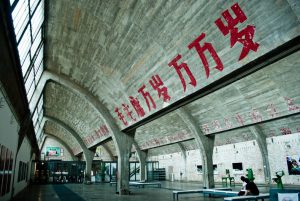
In his book chapter “Building on Disappearance: Hong Kong architecture and colonial space”, Abbas conceptualizes the notion of “disappearance” in an insightful way. To him, the disappearance of Hong Kong architecture takes place at two levels. At the first level of disappearance, the city “reinvents itself every few years” due to the “domination of marketplace”. Buildings and spaces in Hong Kong, however monumental, are subject to demolition and destruction as soon as they become not profitable enough. This ever-changing city landscape reminds us of Karl Marx’s famous comment on capitalism, a system under which “everything that is solid melts into air”. Buildings, solid as they may seem, are extremely fragile when confronted with the invisible hands of the market.
The second level of disappearance, however, is much more difficult to grasp. Abbas argues that in certain circumstances, projects of preservation can ironically become a way of disappearance, a phenomenon he calls “use of preservation as history to bring about the disappearance of history”. Preserved are the physical details of buildings; erased are historical and cultural memories. Such double effect is successfully achieved through “persistence along certain ideological guidelines”, especially the colonial ideology in Hong Kong’s case. The Flagstaff House, a former colonial military building preserved and turned into a museum of Chinese tea, is a typical example of such disappearance. Such practice, according to Abbas, “aestheticizes” colonialism and all its violence “out of existence”.
Abbas’s concept of “disappearance”, especially in its second sense, reminds me instantly of the 798 Art Zone in Beijing. The city Beijing, similar to Hong Kong, had undergone a rapid process of destruction and reconstruction in the last two decades of the 20th century. As the whole nation entered into the “Reform Era” and turned toward capitalism, the pre-1980 old Beijing also “melts into air”. The 798 factory, a former state-owned industrial enterprise, was an exception in that it was fortunate enough to be preserved and turned into an art zone. Nevertheless, this is arguably yet another example of “presence as absence”, or preservation of architecture as the disappearance of history.
Dai Jinhua, a Beijing (Peking) University scholar who is also born and raised in this city, has written an article named “798: Space Where History is Inscribed and Buried” (「798: 銘寫與掩埋歷史的空間」). In this article, Dai argues that the socialist history inscribed in the 798 factory is appropriated and buried by different agents in their separate ways. For instance, the socialist space is used by some Chinese artists as a source for their (often repetitive, sometimes corny) reproduction of Political Pop Art (「政治波普藝術」) works, which are being constantly translated by consumerism into fashionable images on postcards, cups, and T-shirts. On top of that, the space is also utilized as an exotic Oriental-Socialist material to attract the postcolonial/post-Cold-War gaze of certain foreign tourists. Last but not least, under the context of globalization, the space has already been reinvented as a copy of SOHO districts and LOFT houses in international art centers like New York. Consequently, the socialist past inscribed in this space, whether its historical lessons or legacies, are eventually buried and forgotten.
Therefore, we can see that “disappearance” of space and architecture is a phenomenon not limited to Hong Kong. Instead, it can be seen as a global spatial issue. Everywhere, “disappearance” functions to cultivate what Abbas calls “a tendency toward timelessness and placelessness”, modifying and erasing history in the meantime. Loss of historicity, as argued by Fredric Jameson, is precisely the “cultural logic of late capitalism”, the common symptom of our times.
BY Zhu Jieming (UID: 3035448524)
Great understanding of the “Building on Disappearance”. You have mentioned a very good example of 798 Art Zone in Beijing, which has gone through similar preservation and gentrification like Hong Kong despite the difference historical influence. It may be appropriate to also discuss what we are consciously trying to preserve or erase through these buildings, as these buildings become an artefact of the time, whether it is colonial or socialist.